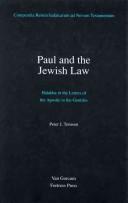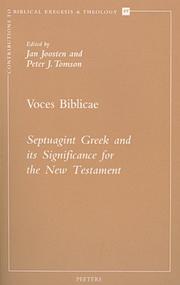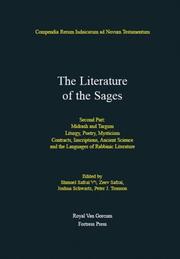| Listing 1 - 5 of 5 |
Sort by
|

ISBN: 9023224906 080062467X 9004275142 Year: 1990 Publisher: Assen Van Gorcum
Abstract | Keywords | Export | Availability | Bookmark
 Loading...
Loading...Choose an application
- Reference Manager
- EndNote
- RefWorks (Direct export to RefWorks)
While interest in Paul's relationship to Judaism has been growing recently, this study adds an important aspect by comparing Paul’s practical instruction with the ancient halakha or Jewish traditional law. First Corinthians is found to be a source of prime importance, and surprisingly, halakha appears to be basic to Paul's instruction for non-Jewish Christians. The book includes thorough discussion of hermeneutic and methodological implications, always viewed in relation to the history of Pauline and Judaic study. Attention is also being paid to the setting within Hellenistic culture. Finally, conclusions are drawn about the texture of Paul's thought and these are applied to two ‘theological’ passages decisive for his place in Judaism. Historical and theological implications are vast, both regarding Paul's relationship to Judaism, his attitude towards Jesus and his Apostles, and the meaning of his teaching concerning justification and the Law.
227.08 --- 296*52 --- Paulinische theologie --- Joodse ethiek: Halacha; Minhag (gewoonten); Tora --- 296*52 Joodse ethiek: Halacha; Minhag (gewoonten); Tora --- 227.08 Paulinische theologie --- Jewish law. --- Law (Theology) --- Biblical law --- Civil law (Jewish law) --- Halacha --- Halakha --- Halakhah --- Hebrew law --- Jews --- Law, Hebrew --- Law, Jewish --- Law, Mosaic --- Law in the Bible --- Mosaic law --- Torah law --- Law, Semitic --- Commandments (Judaism) --- Biblical teaching. --- Law --- Paul, --- Apostolos Paulos --- Būlus, --- Pablo, --- Pál, --- Paolo, --- Paulo, --- Paulos, --- Paulus, --- Pavel, --- Pavol, --- Paweł, --- Pawełm --- Pōghos, --- Saul, --- القديس بولس الرسول --- بولس، --- 사도바울 --- Bible. --- Epistles of Paul --- Paul, Epistles of --- Paul Sŏsin --- Pauline epistles --- Risālat al-Qiddīs Būlus al-rasūl al-thāniyah ilá Tīmūthīʼūs --- Criticism, interpretation, etc. --- Bible --- N.T --- Paul --- the Apostle, Saint.
Article
Abstract | Keywords | Export | Availability | Bookmark
 Loading...
Loading...Choose an application
- Reference Manager
- EndNote
- RefWorks (Direct export to RefWorks)

ISBN: 9789042919150 9042919159 Year: 2007 Volume: 49 Publisher: Leuven Dudley, MA : Peeters,
Abstract | Keywords | Export | Availability | Bookmark
 Loading...
Loading...Choose an application
- Reference Manager
- EndNote
- RefWorks (Direct export to RefWorks)
Greek language, Biblical --- Grec biblique --- Terms and phrases. --- Mots et locutions --- Bible. --- Language, style. --- Versions --- Septuagint --- Terms and phrases --- Language, Style --- Language, style --- 221.02*3 --- 225.02*3 --- Oud Testament: bijbelse filologie: grieks; septuagint --- Nieuw Testament: Griekse bijbelse filologie --- 225.02*3 Nieuw Testament: Griekse bijbelse filologie --- 221.02*3 Oud Testament: bijbelse filologie: grieks; septuagint --- Ba-yon Tipan --- Bagong Tipan --- Jaji ma Hungi --- Kainē Diathēkē --- New Testament --- Nouveau Testament --- Novo Testamento --- Novum Testamentum --- Novyĭ Zavet --- Novyĭ Zavi︠e︡t Gospoda nashego Īisusa Khrista --- Novyĭ Zavit --- Nuevo Testamento --- Nuovo Testamento --- Nye Testamente --- Perjanjian Baru --- Dhamma sacʻ kyamʻʺ --- Injīl --- Greek language, Biblical - Terms and phrases --- Bible --- Grec (langue) biblique --- Versions grecques --- Septante --- Langue
Multi
ISSN: 18774970 ISBN: 9789004349865 9004349863 9789004352971 900435297X Year: 2018 Volume: 15 Publisher: Leiden Brill
Abstract | Keywords | Export | Availability | Bookmark
 Loading...
Loading...Choose an application
- Reference Manager
- EndNote
- RefWorks (Direct export to RefWorks)
This work discusses crucial aspects of the period between the two revolts against Rome in Judaea that saw the rise of rabbinic Judaism and of the separation between Judaism and Christianity. Most contributors no longer support the ?maximalist ? claim that around 100 CE, a powerful rabbinic regime was already in place. Rather, the evidence points to the appearance of the rabbinic movement as a group with a regional power base and with limited influence. The period is best seen as one of transition from the multiform Judaism revolving around the Second Temple in Jerusalem to a Judaism that was organized around synagogue, Tora, and sages and that parted ways with Christianity"
Christian church history --- Jewish religion --- anno 100-199 --- anno 1-99 --- Judaism --- Christianity and other religions --- 296*82 --- Jews --- Religions --- Semites --- 296*82 Dialoog joden - christenen --- Dialoog joden - christenen --- Relations&delete& --- Christianity --- Religion --- Rome --- History --- Judaïsme --- --Christianisme --- --Relation --- --Antiquité --- --Congrès --- --2015 --- --Ramat-Gan, Israël --- --actes --- --Judaïsme --- --Christian church history --- --Judaism --- Relations --- Brotherhood Week --- Christianisme --- Relation --- Antiquité --- Congrès --- Ramat-Gan, Israël --- Christians --- Religious adherents --- Hebrews --- Israelites --- Jewish people --- Jewry --- Judaic people --- Judaists --- Ethnology --- Judaïsme

ISBN: 902324222X 9789023242222 080060606X 9780800606060 9004275126 Year: 2006 Volume: 3b Publisher: Assen Van Gorcum
Abstract | Keywords | Export | Availability | Bookmark
 Loading...
Loading...Choose an application
- Reference Manager
- EndNote
- RefWorks (Direct export to RefWorks)
This long-awaited companion volume to The Literature of the Sages , First Part (Fortress Press, 1987) brings to completion Section II of the renowned Compendia series. The Literature of the Sages, Second Part, explores the literary creation of thousands of ancient Jewish teachers, the often- anonymous Sages of late antiquity and the Middle Ages. Essays by premier scholars provide a careful and succinct analysis of the content and character of various documents, their textual and literary forms, with particular attention to the ongoing discovery and publication of new textual material. Incorporating groundbreaking developments in research, these essays give a comprehensive presentation published here for the first time. This volume will prove an important reference work for all students of ancient Judaism, the origins of Jewish tradition, and the Jewish background of Christianity. The literary creation of the ancient Jewish teachers or Sages – also called rabbinic literature – consists of the teachings of thousands of Sages, many of them anonymous. For a long period, their teachings existed orally, which implied a great deal of flexibility in arrangement and form. Only gradually, as parts of this amorphous oral tradition became fixed, was the literature written down, a process that began in the third century C.E. and continued into the Middle Ages. Thus the documents of rabbinic literature are the result of a remarkably long and complex process of creation and editing. This long-awaited companion volume to 'The Literature of the Sages, First Part' (1987) gives a careful and succinct analysis both of the content and specific nature of the various documents, and of their textual and literary forms, paying special attention to the continuing discovery and publication of new textual material. Incorporating ground-breaking developments in research, these essays give a comprehensive presentation published here for the first time. 'The Literature of the Sages, Second Part' is an important reference work for all students of ancient Judaism, as well as for those interested in the origins of Jewish tradition and the Jewish background of Christianity.
Jewish religion --- Jewish religious literature --- History and criticism. --- Judaïsme --- 296*1 --- Hebreeuwse bijbel: targum; midrasj; bijbelcommentaren; haggadische verzamelingen--(algemeen) --- Rabbinical literature --- 296*1 Hebreeuwse bijbel: targum; midrasj; bijbelcommentaren; haggadische verzamelingen--(algemeen) --- History and criticism --- Jewish religious literature. --- Rabbinical literature. --- Hebrew literature --- Jewish literature --- Religious literature, Jewish --- Religious literature --- Jewish religious literature - History and criticism
| Listing 1 - 5 of 5 |
Sort by
|

 Search
Search Feedback
Feedback About UniCat
About UniCat  Help
Help News
News